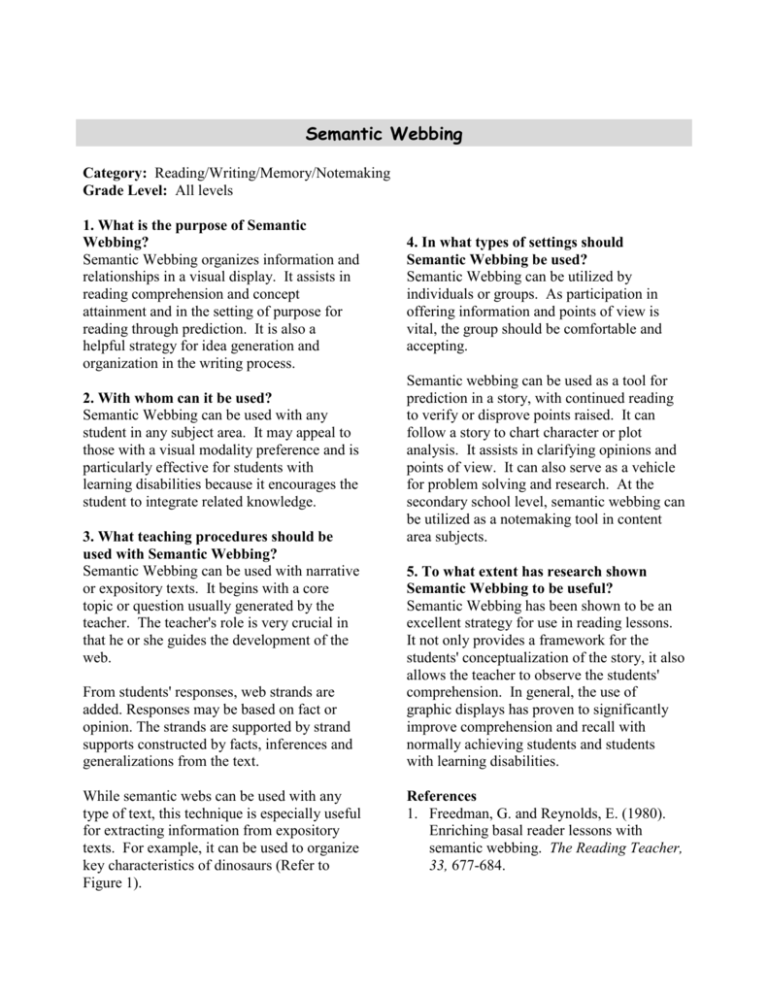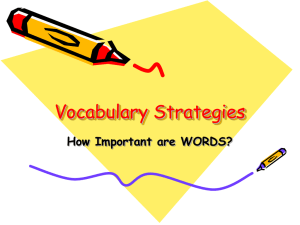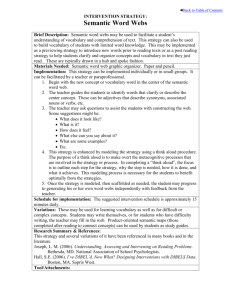Semantic Webbing
advertisement

Semantic Webbing Category: Reading/Writing/Memory/Notemaking Grade Level: All levels 1. What is the purpose of Semantic Webbing? Semantic Webbing organizes information and relationships in a visual display. It assists in reading comprehension and concept attainment and in the setting of purpose for reading through prediction. It is also a helpful strategy for idea generation and organization in the writing process. 2. With whom can it be used? Semantic Webbing can be used with any student in any subject area. It may appeal to those with a visual modality preference and is particularly effective for students with learning disabilities because it encourages the student to integrate related knowledge. 3. What teaching procedures should be used with Semantic Webbing? Semantic Webbing can be used with narrative or expository texts. It begins with a core topic or question usually generated by the teacher. The teacher's role is very crucial in that he or she guides the development of the web. From students' responses, web strands are added. Responses may be based on fact or opinion. The strands are supported by strand supports constructed by facts, inferences and generalizations from the text. While semantic webs can be used with any type of text, this technique is especially useful for extracting information from expository texts. For example, it can be used to organize key characteristics of dinosaurs (Refer to Figure 1). 4. In what types of settings should Semantic Webbing be used? Semantic Webbing can be utilized by individuals or groups. As participation in offering information and points of view is vital, the group should be comfortable and accepting. Semantic webbing can be used as a tool for prediction in a story, with continued reading to verify or disprove points raised. It can follow a story to chart character or plot analysis. It assists in clarifying opinions and points of view. It can also serve as a vehicle for problem solving and research. At the secondary school level, semantic webbing can be utilized as a notemaking tool in content area subjects. 5. To what extent has research shown Semantic Webbing to be useful? Semantic Webbing has been shown to be an excellent strategy for use in reading lessons. It not only provides a framework for the students' conceptualization of the story, it also allows the teacher to observe the students' comprehension. In general, the use of graphic displays has proven to significantly improve comprehension and recall with normally achieving students and students with learning disabilities. References 1. Freedman, G. and Reynolds, E. (1980). Enriching basal reader lessons with semantic webbing. The Reading Teacher, 33, 677-684. 2. Horton, S. V., Lovitt, T. C., and Bergerud, D. (1990). The effectiveness of graphic organizers for three classifications of secondary students in content area classes. Journal of Learning Disabilities, 23, 1229. 3. Idol, L. (1987). Group story mapping: A comprehension strategy for both skilled and unskilled readers. Journal of Learning Disabilities, 20, 196-205. 4. Idol, L. and Croll, V. (1987). Story mapping training as a means of improving reading comprehension. Learning Disability Quarterly, 10, 214-229. 5. Peresich, M.L., Meadows, J.D. and, Sinatra, R. (1990). Content area cognitive mapping for reading and writing proficiency. Journal of Reading, 33, 424432. 6. Sinatra, R.C., Berg, D., and Dunn, R. (1985). Semantic mapping improves reading comprehension of learning disabled students. Teaching Exceptional Children, 17, 310-314. Figure 1. Semantic Web Some are meat eaters A type of animal Some are plant eaters Dinosaurs Lays eggs Some can fly Extinct






